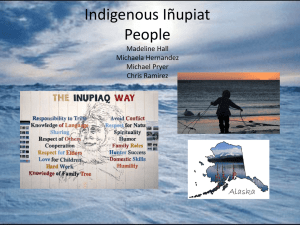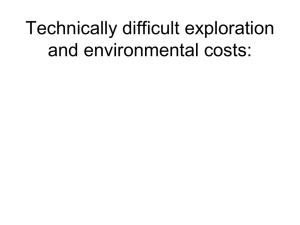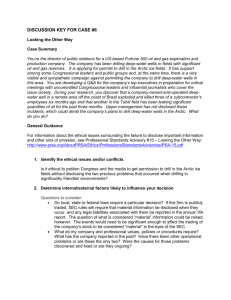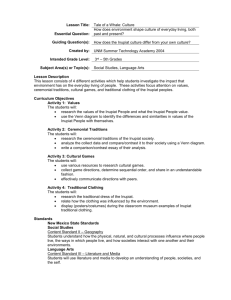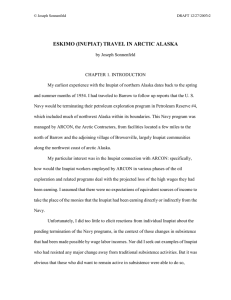essay #3 - the NBTSC Community Site!
advertisement
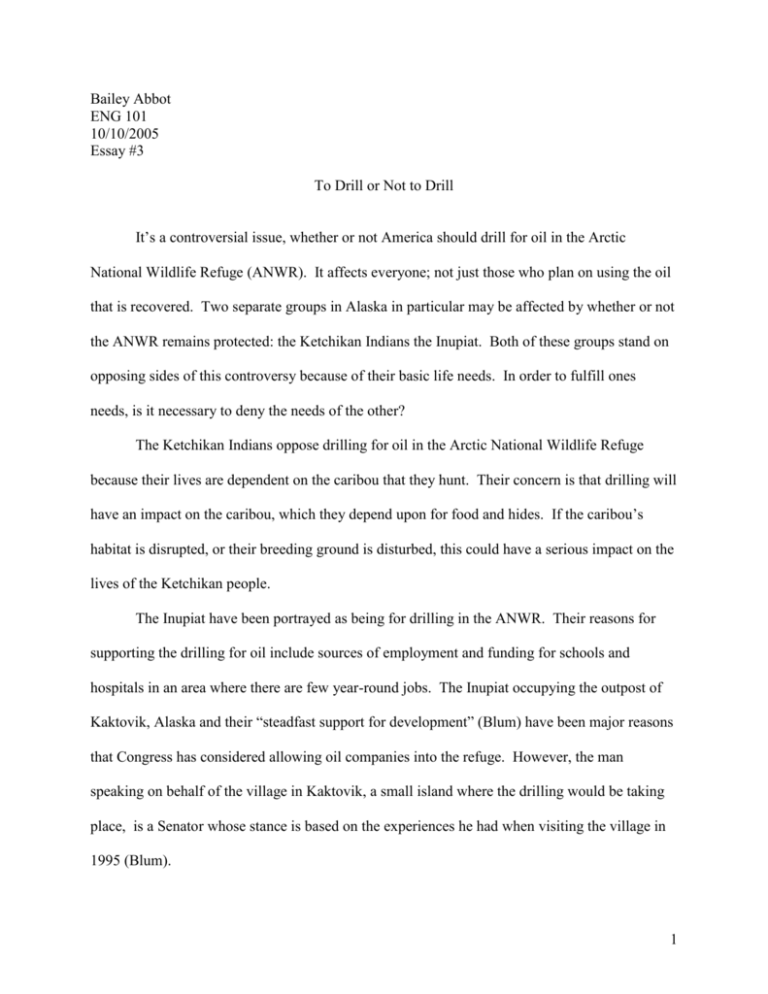
Bailey Abbot ENG 101 10/10/2005 Essay #3 To Drill or Not to Drill It’s a controversial issue, whether or not America should drill for oil in the Arctic National Wildlife Refuge (ANWR). It affects everyone; not just those who plan on using the oil that is recovered. Two separate groups in Alaska in particular may be affected by whether or not the ANWR remains protected: the Ketchikan Indians the Inupiat. Both of these groups stand on opposing sides of this controversy because of their basic life needs. In order to fulfill ones needs, is it necessary to deny the needs of the other? The Ketchikan Indians oppose drilling for oil in the Arctic National Wildlife Refuge because their lives are dependent on the caribou that they hunt. Their concern is that drilling will have an impact on the caribou, which they depend upon for food and hides. If the caribou’s habitat is disrupted, or their breeding ground is disturbed, this could have a serious impact on the lives of the Ketchikan people. The Inupiat have been portrayed as being for drilling in the ANWR. Their reasons for supporting the drilling for oil include sources of employment and funding for schools and hospitals in an area where there are few year-round jobs. The Inupiat occupying the outpost of Kaktovik, Alaska and their “steadfast support for development” (Blum) have been major reasons that Congress has considered allowing oil companies into the refuge. However, the man speaking on behalf of the village in Kaktovik, a small island where the drilling would be taking place, is a Senator whose stance is based on the experiences he had when visiting the village in 1995 (Blum). 1 A petition that circulated last spring collected signatures from 30% of adults in the community (Blum). While being unclear on the stance of the other 2/3 of the community, it is misleading to claim that the majority are in support, let alone that their support is “steadfast” (Blum). Many of the residents of this village are concerned that drilling could expand to waters offshore, affecting whale migration. The annual bowhead whale hunt is a time honored tradition that “unifies residents and provides food for three community celebrations and other meals” (Blum). The blubber and skin of the whale is dispersed all throughout the island of Kaktovik. Artists use baleen, the bones that stream the plankton that the whales digest, are used to create intricate carvings (Blum). Not all the residents are against the drilling. In most Inupiat villages employment options are “limited to positions such as school maintenance man, postmaster, airline station agent, village store manager, and possibly school cook or teacher aide… other adults gain income through the sale of furs, fish, or arts and crafts; find seasonal employment away from the villages as firefighters, cannery workers, or construction laborers…[or] depend upon welfare payments” (The Economics of Dependency). Some are hopeful that drilling could open the job force, since there are so few jobs available year-round. Unfortunately, oil drilling in the Arctic National Wildlife Refuge may not be the answer to this problem. Drilling would create jobs at the minimum entry level and could “succeed only to the extent they redistribute unemployment rather than alleviate it” (The Economics of Dependency). Hiring the Inupiat at minimum entry level positions means that most likely they will paid low salaries, and most likely still not be able to afford to support themselves. George F. Will mocks Senator John Kerry’s statement that the oil reserves in ANWR are “a few drops” compared to the rest of the world’s supply. Will is correct; the oil in the refuge 2 could produce what we are currently importing now for 25 years. However, what happens to the jobs created for the Inupiat if drilling ceases after those 25 years? Ignoring for the moment the issue with hiring Inupiat workers only at minimum entry-level jobs, these jobs will disappear when the last of the oil has been collected. For the Inupiat, this would be at most a temporary solution. Wouldn’t it be better to work towards a more permanent one, with an employment source that hopefully isn’t going to dry up after 3.2 – 11.5 billion barrels? The argument that we should open the ANWR to drilling in order to help create more jobs for native Alaskans is one that is being exploited for the oil industry’s agenda. Before claiming the “steadfast” support of the people, maybe Congress should go back and see where the people actually stand today on this issue. As with any idea, people’s opinions can change, and it doesn’t make sense to be relying on information that is 10 years old. In trying to balance the needs of both the Inupiat and the Ketchikan, it may be that what they both want and need are more similar than what was originally thought. 3 Works Cited Barnett, Sylvan and Hugo Bedau. From Critical Thinking to Argument: A Portable Guide. Boston: Bedford/St. Martin’s, 2005. Blum, Justin. “Alaska Town Split Over Drilling in Wildlife Refuge: Oil Money Tantalizes, but Many Fear Effect on Way of Life.” Washington Post 23 April 2005: A01. 10 Oct. 2005. <http://www.washingtonpost.com/wp- dyn/content/article/2005/04/22/AR20050422018 32_pf.html> “The Economics of Dependency.” Ethnographic Portraits: Inupiat of Arctic Alaska. 10 Oct. 2005. <http://www.arcticcircle.uconn.edu/HistoryCulture/Inupiat/econdependency.html> Will, George F. “Being Green at Ben and Jerry’s: Some Environmental Policies Are Feel-Good Indulgences for an Era of Energy Abundance.” Barnett, Sylvan and Hugo Bedau 74-76. 4


